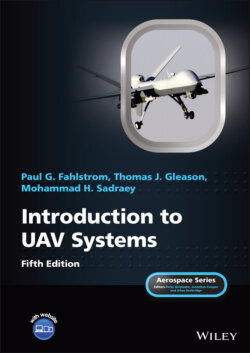Читать книгу Introduction to UAV Systems - Mohammad H. Sadraey - Страница 70
3.3 Mach Number
ОглавлениеIt is customary to compare the speed of an air vehicle (V) with the speed of sound (a). The Mach number is defined as the ratio of airspeed over the speed of sound:
(3.3)
The speed of sound at the sea level standard condition is 340 m/s. M is used to define four different flight regimes for airspeed: (1) subsonic, (2) transonic, (3) supersonic, and (4) hypersonic.
When the flight speed is less than the speed of sound – where M < 1 – it is defined as subsonic speed. When 0.8 ≤ M ≤ 1.2, the flight regime is loosely defined as transonic. If the flight speed is less than the speed of sound, but M is sufficiently near 1, the airflow expansion over the top surfaces of the wing/tail/fuselage may result in locally supersonic regions. A flowfield where M > 1 everywhere is defined as supersonic. At supersonic speeds, a shock wave (e.g., normal, oblique, and bow) is created by nature to adjust the flow properties (e.g., air pressure and temperature).
The flow regime for M > 5 is given a special label, hypersonic flow. For values of M > 5, the shock wave is very close to the surface, and the flowfield between the shock and the body (the shock layer) becomes very hot indeed, hot enough to dissociate or even ionize the gas. The aerodynamic characteristics of an air vehicle is strongly a function of Mach number, some of which will be discussed in this chapter.
